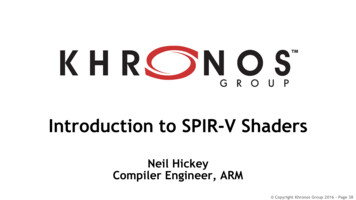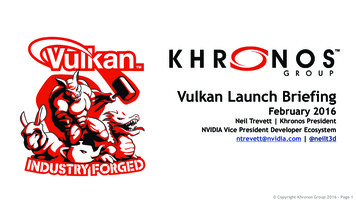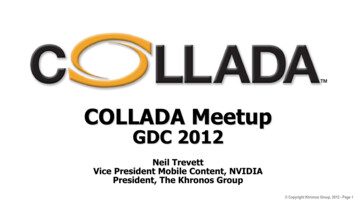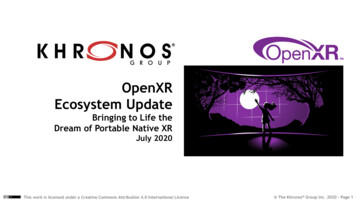
Transcription
Tutorial, part IIWeb3D symposium04/2007Dr. Rémi ArnaudSony Computer Entertainment Copyright Khronos Group, 2007 - Page 1
Agenda Goals and accomplishments COLLADA business model COLLADA and X3D COLLADA FX & Physics COLLADA XML design COLLADA Roadmap Q&A sessionPS3 ducky - Image courtesy of Sony Computer Entertainmen Copyright Khronos Group, 2007 - Page 2
Design Goals (1) Content creation has become increasingly demanding-3D devices expands in complexity and capabilitiesSize of content ever growingShrinking production schedulesEver growing budgetsDevice capabilityContent production DCC tools not keeping pace with technology-Dynamic contentShader FXPhysicsCollaborative development Need Export and Import !-Need flexibility creating content pipelineEnable mixing tools for better productivityOpening the door to a variety of third party toolsNeed a language – import and export required for true communication Copyright Khronos Group, 2007 - Page 3
Design Goals (2) Improve Asset Management System- Assets are not files, but XML elements- Interactive development- Collaborative design Content pipeline processing- Contain enough information to enable creation of target optimized format- Can store both DCC centric formatted data and game engine data- Polygons with holes- Triangle strips Extensibility- Final user can easily extend the features- Extension by substitution- Extension by addition- Tool vendors can add elements- Tool specific data for no-loss import / export- Candidate for standardization in future releases Modularity- Libraries of assets- Many things can be externally referenced Need validation capability- Syntax to be validated, regardless of the content- XML Schema validation- Need to enable verification of exporter and importer quality- COLLADA needs a full fledge conformance test Copyright Khronos Group, 2007 - Page 4
Objectives Raise the quality and feature set of contentLiberate content from proprietary formats and APIBring more tools to developers/artistsDrastically improve productivityLower the barrier to entry for tool & middleware companiesBring ‘advanced’ features into the main streamEnable user content flow Copyright Khronos Group, 2007 - Page 5
COLLADA adopted by Khronos COLLADA 1.4.0 adopted as industry standard by Khronos 01/06- Not an API, COLLADA is a language- Intermediate Digital Asset Exchange format (.dae)- XML Schema technology is the first standard specificationwww.khronos.org/collada Copyright Khronos Group, 2007 - Page 6
Status 1.4.1 released August 2006- Patch update from 1.4.0 Thousands of active users- Many professional game developers currently using COLLADA- THQ, EA, Konami, NCsoft, DoubleFine, Rockstar - Unreal Engine, C4 engine, Ogre, Irrlicht Engine, - Approaching 15,000 1.4.1 spec download Adopted by Google Earth for 3D models- COLLADA content manipulated by mainstream users- SketchUp, 3D warehouse- Photomodeler, realviz, 3D nature . More DCC tools have COLLADA support-Since COLLADA 1.0: 3dsMax, Maya, XSISince COLLADA 1.4.x: Blender, HoudiniPhotoshop CS3 extended introduces 3D, with COLLADA supportWork in progress: DAZ, Modo, Lightwave Official conformance test in development- Early access available to Khronos members- Publicly available reference viewer and coherency testPS3 ducky on earthImage courtesy of Google Inc (earth.google.com) Copyright Khronos Group, 2007 - Page 7
Agenda Goals and accomplishments COLLADA business model COLLADA and X3D COLLADA FX & Physics COLLADA XML design COLLADA Roadmap Q&A sessionDigital Berlin – 44000 COLLADA buildings ! Copyright Khronos Group, 2007 - Page 8
Why contribute to COLLADA ? There is only one good reason for standards to exist:- Companies supporting the standard make/save money if the standard exists- Contributing is expensive (resource, IP, membership)- Benefit need to be much higher than cost Follow the money- Sony Computer Entertainment make money selling content (games)- Better content more customers larger business- Better content tools cheaper content more incentive to create better content - (Graphics) Hardware companies make money selling chips.- Need to keep the market hungry for more features/performance- Need more advanced content - Also need standard API.- Digital Content Creation tools- Need to create content that can be used- Customers do not want their data prisoner of the tool- WARNING - Monopoles do not agree with this, they want to own your data, so you have topay to get to it. (undocumented binary formats, licensed API – so source code).- Google makes money selling advertisement and technology- The more users the more money- Content need to be attractive and entertaining- Focusing on user content Copyright Khronos Group, 2007 - Page 9
Why adding COLLADA support ? Yet another format ?- Reduce the number of formats you have to support – get rid of vintage formats- example: RealViz went from 6 to 1 format to support- Grow your customer base- COLLADA let you interface with more tools, in different business sectors- Example: SketchUp entry in the game industry for rapid prototyping- Follow COLLADA feature set and roadmap- Start with geometry and textures- Then add animation, physics, skinning .- This provides your customer a clear roadmap, and a definite way to get there“We decided to use COLLADA because there are many features I do not yet support”- Stop wasting money writing exporters and fighting with DCC SDK bug- Max Maya Softimage . exporters is more expensive than 1 COLLADA importer- Reduce your support cost- COLLADA validation and coherency test- Exporters are supported, report the bug and let them do the work Copyright Khronos Group, 2007 - Page 10
Example COLLADA businesses Feeling Software - contractor- COLLADA plug-ins development for tool vendors- Gold support contracts for developers- Special projects – highly competitive due to re-use of COLLADA technology Pixel Academy - game developer- COLLADA 101 Web course- Special training sessions- Advanced follow-up trainings- Game development with COLLADA- Other business opportunities-COLLADA asset management and content pipeline toolsCOLLADA asset creation (sub-contracting to game developers)COLLADA binary distribution format (codec)COLLADA community / user content (flikr / youtube for 3D) Copyright Khronos Group, 2007 - Page 11
Agenda Goals and accomplishments COLLADA business model COLLADA and X3D COLLADA FX & Physics COLLADA XML design COLLADA Roadmap Q&A sessionImage courtesy of DAZ Production (www.daz3d.com) Copyright Khronos Group, 2007 - Page 12
Developing Web Applications with COLLADA and X3DA WhitepaperDr. Rémi Arnaudremi@collada.orgSony Computer EntertainmentTony Parisitparisi@mediamachines.comMedia Machines, Inc.March 25, 2007 Copyright Khronos Group, 2007 - Page 13
Comparing COLLADA and X3D COLLADA is an intermediate format- COLLADA enables the transformation of assets as they journey from content tools that usehigher level description paradigms to applications that require platform-specific optimizeddescriptions.- COLLADA enables the free exchange of asset data, enabling developers to construct anauthoring pipeline from multiple tools X3D is a delivery format- X3D focuses on the visualization of 3D assets within applications. X3D has principally beentargeted for the Web (thus the name and focus of the Web3D Consortium- X3D specifies behaviors and interaction, and it includes both a specific run-time model thatenables picking, viewing, navigation, and scripting, and an API to manipulate the scene graphat run-time.X3D picks up where COLLADA leaves offCOLLADA defines the format for 3D assets but not their runtime semantics,leaving that job to the application writer. Copyright Khronos Group, 2007 - Page 14
Using COLLADA for X3D Applications3dsMaxMayaApplication DevelopmentXSI DCC toolsto Game EngineFXComposerCOLLADAto Google EarthPhysics editorRefineryto X3DFlux StudioFlux PlayerSwirlX3D StudioXj3D ToolkitWireFusionAsset CreationX3D X3D Players Publishing Tools Copyright Khronos Group, 2007 - Page 15
Quality COLLADA-to-X3D convertersSketchup - COLLADA - 3D Warehouse - Flux Studio - X3D - Web page“mashup” between Google Maps and 3D modelsImage Courtesy Media Machines, Inc. Copyright Khronos Group, 2007 - Page 16
COLLADA or X3D – Which Should I Use? Example 1- Your application is a content-creation tool and you want your users to be able to developassets for many markets. In this case, COLLADA is the appropriate choice. If in addition youwant to target X3D run-time systems with value-added features such as interactivity, you mayalso want to implement support for X3D standards directly rather than going through anadditional conversion. Typical applications include DCC tool such as 3dsMax, Maya, andSoftimage. Example 2- Your application is a content-editing tool targeting 3D Web publishing. In this case youwould implement only the X3D format. Typical applications include Flux Studio, WireFusion,and SwirlX3D. Example 3- Your application is a run-time application that can take advantage of the X3D run-timemodel. You use X3D directly, and use an X3D player as your application engine. Typicalplayers include Flux Player, FreeWrl, and Xj3D. These applications can also directly loadCOLLADA content, if it makes sense to display content on the Web without any run-timeinteractivity, or use the COLLADA asset as an embedded object within a larger application (anX3D object type known as an “Inline”). Copyright Khronos Group, 2007 - Page 17
COLLADA or X3D – Which Should I Use? Example 4- Your application is a run-time application that requires its own specific run-time. In thiscase, use COLLADA in your toolchain, and create a COLLADA - “Your Format” converter atthe end of the toolchain. Typical applications include video games. Example 5- Your application is a run-time application that does not need to support X3D run-timespecifics, but needs to be able to accept content from a variety of sources. In this case,directly load COLLADA in your application; you do not provide an off-line converter. Typicalapplications include Google Earth. Copyright Khronos Group, 2007 - Page 18
COLLADA & X3D – Ongoing collaboration COLLADA and X3D not only interoperate, but provide significant long-term valueto content and application developers world wide. X3D development community can now take advantage of quality DCC toolCOLLADA support, and save considerable effort by focusing on good qualityCOLLADA-to-X3D converters COLLADA and X3D teams have begun to identify areas where entire parts of onestandard might be adopted for use directly within the other, starting with Physics Ideally, in the future, since both COLLADA and X3D are based upon XML, X3Dmight be able to directly accept COLLADA content without any conversion. tparisi@mediamachines.com The authors encourage questions and feedback on this whitepaper. Copyright Khronos Group, 2007 - Page 19
Agenda Goals and accomplishments COLLADA business model COLLADA and X3D COLLADA FX & Physics COLLADA XML design COLLADA Roadmap Q&A sessionPhotoshop - Image courtesy Adobe Systems Incorporated Copyright Khronos Group, 2007 - Page 20
NVIDIA FXComposer 2.0 - a breakthroughImage courtesy of NVIDIA Copyright Khronos Group, 2007 - Page 21
User Interface Overview Management- Project Explorer- Library w Coding- Modify shader code Properties- Modify parameter values Preview- Multiple platform views Info- Tasks and errors- Python scripting- Shader Performance Textures- Explore image resources- View render targets Copyright Khronos Group, 2007 - Page 22
TOOLS Edit/import/export COLLADA FX-FXComposer 2.03dsMaxMayaSoftimage XSI Parameters are expressed outside of the shader programs- Tools can deal with FX even if they cannot use the programs- i.e. 3dsMax supports only HLSL- Note – latest version has now Cg support as well COLLADA supports multiple profile- CG, GLSL, GLSL ES, can all be specified- Same FX definition, different languages- Extensible – Renderman extension available- Copyright Khronos Group, 2007 - Page 23
COLLADA PhysicsImages courtesy of Feeling Software (www.feelingsoftware.com), Bullet physics library (www.continuousphysics.com/Bullet/)and AGEIA (www.ageia.com) Copyright Khronos Group, 2007 - Page 24
geometry Copyright Khronos Group, 2007 - Page 25
Analytic shapes – for physics only Copyright Khronos Group, 2007 - Page 26
Tools and engines COLLADA Physics plug-ins for 3dsMax, Maya, Blender. Bullet engine is an open source physics engine available for many platforms,including the PLAYSTATION 3. It provides a physics viewer, which displays onlythe analytic shapes and show the effect of the physics, which can be used as atool by a developer, even if using a different engine for the target platform. Both Bullet and AGEIA physics API offer the ability to export a COLLADAPhysics document at any time during the simulation. This document contains allthe values at the specific simulation time, providing a full snapshot of the physicsengine. Those snapshots are really helpful to debug physics issues. Most issuesare the result of incorrect data, that can be difficult to find without the COLLADAPhysics snapshot and COLLADA Physics specialized viewers and tools. The AGEIA PhysX Rocket tool can import and export COLLADA documents withphysics, as well as present an interface to let developers tweak any physicalparameters.Toward a PhysicsComposer tool ? Copyright Khronos Group, 2007 - Page 27
COLLADA Physics and Animation COLLADA defines the constrained joints and rigid body properties COLLADA also store the animation that will be applied to some of the joints(motor), the physics engine does the rest of the animation Copyright Khronos Group, 2007 - Page 28
Agenda Goals and accomplishments COLLADA business model COLLADA and X3D COLLADA FX & Physics COLLADA XML design COLLADA Roadmap Q&A sessionImage courtesy of Feeling Software (www.feeelingsoftwrea.com) Copyright Khronos Group, 2007 - Page 29
1.4.x Features Mesh GeometryTransform hierarchy (rotation, translation, shear, scale, matrix)MaterialsTexturesShader programs (Cg, GLSL, HLSL, GLES)Shader effects (FX)LightsCamerasSkinning / bonesAnimationPhysics (rigid bodies, constraints, rag dolls, collision ssetsUser data Copyright Khronos Group, 2007 - Page 30
Geometry Schema Geometry as data-flow- Vertices are still the norm.- Attributes are variable.- Meshes contain vertices- Describes the shape / topology of the geometry.- Lots of high frequency data. accessor ( source ) Î input ( mesh ) Copyright Khronos Group, 2007 - Page 31
geometry Geometry element- Contains various types of descriptions.- Instantiated into the scene.- Stored in the library geometies element Copyright Khronos Group, 2007 - Page 32
geometry Copyright Khronos Group, 2007 - Page 33
mesh Mesh element- One or more source - Exactly one vertices - Zero or more primitives(e.g. point clouds) Copyright Khronos Group, 2007 - Page 34
mesh Copyright Khronos Group, 2007 - Page 35
source Data source element- Raw data stream- Strongly typed array- No semantics Copyright Khronos Group, 2007 - Page 36
source Copyright Khronos Group, 2007 - Page 37
accessor Data accessor element- source output interface- Describes how to access the source data- Data can be stored externally Copyright Khronos Group, 2007 - Page 38
mesh Mesh element- One or more source - Exactly one vertices - Zero or more primitives Copyright Khronos Group, 2007 - Page 39
vertices Mesh vertex element-Groups mesh vertex attribute dataCollect data independent to primitive assembly“POSITION” semantic requiredUnlimited attributesnDimentional data OK Copyright Khronos Group, 2007 - Page 40
mesh Copyright Khronos Group, 2007 - Page 41
COLLADA polygons Polygons element- Collates vertices into primitives.- General primitive, can handle holes- Complex non planar polygons OK Copyright Khronos Group, 2007 - Page 42
COLLADA polygons Input streams- Possible Input semantics:VERTEXTEXCOORDNORMALCOLORBINORMALUV Copyright Khronos Group, 2007 - Page 43
Geometry example (1) A super cool box geometry id "box" name “super cool box" mesh source id "box-Pos" float array id "box-Pos-array" count "24" -0.5 0.5 0.5 0.5 0.5 0.5 -0.5 -0.5 0.5 0.5 -0.5 0.5-0.5 0.5 -0.5 0.5 0.5 -0.5 -0.5 -0.5 -0.5 0.5 -0.5 -0.5 /float array technique common accessor source "#box-Pos-array" count "8" stride "3" param name "X" type "float"/ param name "Y" type "float"/ param name "Z" type "float"/ /accessor /technique common /source source id “box-0-Normal” . Copyright Khronos Group, 2007 - Page 44
Geometry example (2) vertices id "box-Vtx" input semantic "POSITION" source "#box-Pos"/ /vertices polygons count "3" material "RED" input semantic "VERTEX" source "#box-Vtx" offset "0"/ input semantic "NORMAL" source "#box-0-Normal" offset "1"/ p 0 4 2 4 3 4 1 4 /p p 0 2 1 2 5 2 4 2 /p p 6 3 7 3 3 3 2 3 /p /polygons polygons count "3" material "BLUE" input semantic "VERTEX" source "#box-Vtx" offset "0"/ input semantic "NORMAL" source "#box-0-Normal" offset "1"/ p 0 1 4 1 6 1 2 1 /p p 3 0 7 0 5 0 1 0 /p p 5 5 7 5 6 5 4 5 /p /polygons /mesh /geometry Copyright Khronos Group, 2007 - Page 45
Geometry example (3) Vertex data stream geometry id "box" name “super cool box" mesh “box-Pos” source id "box-Pos" float array id "box-Pos-array"“box-Pos-array”count "24" . technique common accessor source "#box-Pos-array"“#box-Pos-array”count "8" stride "3" /source source id "box-Normal" vertices id "box-Vtx" box-Vtx”“#box-Pos” input semantic "POSITION" source "#box-Pos"/ /vertices polygons count "3" material "RED" input semantic "VERTEX" source "#box-Vtx"“#box-Vtx”offset "0"/ input semantic "NORMAL" source "#box-Normal" offset "1"/ Copyright Khronos Group, 2007 - Page 46
Geometry example (4) Normal data stream geometry id "box" name “super cool box" mesh “box-Pos” source id "box-Pos" float array id "box-Pos-array"“box-Pos-array”count "24" . technique common accessor source "#box-Pos-array"“#box-Pos-array”count "8" stride "3" /source “box-Normal” source id "box-Normal" vertices id "box-Vtx" “box-Vtx”“#box-Pos” input semantic "POSITION" source "#box-Pos"/ /vertices polygons count "3" material "RED" input semantic "VERTEX" source "#box-Vtx"“#box-Vtx”offset "0"/ input semantic "NORMAL" source "#box-Normal"“#box-Normal” offset "1"/ Copyright Khronos Group, 2007 - Page 47
geometry Copyright Khronos Group, 2007 - Page 48
NURBS curves imported from Maya into 3dsMax Copyright Khronos Group, 2007 - Page 49
1.4.x Features Mesh GeometryTransform hierarchy (rotation, translation, shear, scale, matrix)MaterialsTexturesShader programs (Cg, GLSL, HLSL, GLES)Shader effects (FX)LightsCamerasSkinning / bonesAnimationPhysics (rigid bodies, constraints, rag dolls, collision ssetsUser data Copyright Khronos Group, 2007 - Page 50
Material Assign material to geometry symbolically vertices id "box-Vtx" input semantic "POSITION" source "#box-Pos"/ /vertices polygons count "3" material "RED" input semantic "VERTEX" source "#box-Vtx" offset "0"/ input semantic "NORMAL" source "#box-0-Normal" offset "1"/ p 0 4 2 4 3 4 1 4 /p p 0 2 1 2 5 2 4 2 /p p 6 3 7 3 3 3 2 3 /p /polygons polygons count "3" material "BLUE" input semantic "VERTEX" source "#box-Vtx" offset "0"/ input semantic "NORMAL" source "#box-0-Normal" offset "1"/ p 0 1 4 1 6 1 2 1 /p p 3 0 7 0 5 0 1 0 /p p 5 5 7 5 6 5 4 5 /p /polygons /mesh /geometry Copyright Khronos Group, 2007 - Page 51
Instance and material binding library visual scenes - Document can store many scenes scene - Default scene for this document- instance visual scene url "#. node name “Box” id “Box” - Scene contains nodes instance geometry url “box” - Instance geometries from library geometries bind material - This is how instanced geometry get their final material technique common instance material symbol "RED" target "#redMaterial"/ instance material symbol "BLUE" target "#blueMaterial"/ -Now RED and BLUE have a real material bound Copyright Khronos Group, 2007 - Page 52
material and effect Stored in the library materials material is an instanced of an effect effect is stored in library effects A document containing effects is called a COLLADA FX documentIn short an effect is a full list of commands for the GPU subsystemSince there is no standard, COLLADA FX is using profiles:CG profile (cross API/platform), GL 2.0 (GLSL), DX (HLSL), OpenGL ES 1.x,OpenGL ES 2.0 (GLSL ES) profile COMMON effect defines some basic rendering for prototypingand basic interchange- Constant, Lambert, Phong, Blinn- Mandatory for conformant files, can have several profiles for same effect Copyright Khronos Group, 2007 - Page 53
1.4.x Features Mesh GeometryTransform hierarchy (rotation, translation, shear, scale, matrix)MaterialsTexturesShader programs (Cg, GLSL, HLSL, GLES)Shader effects (FX)LightsCamerasSkinning / bonesAnimationPhysics (rigid bodies, constraints, rag dolls, collision ssetsUser data Copyright Khronos Group, 2007 - Page 54
Texture Mapping (1) material image id "img01" init from image file.tga /init from . effect newparam sid "surface" surface init from img01 /init from /surface /newparam newparam sid "sampler" sampler2D source surface /source /sampler2D /newparam profile COMMON phong diffuse texture texture "sampler" texcoord “myUVs"/ material material id "material id" instance effect url "#effect id" / /material Copyright Khronos Group, 2007 - Page 55
Texture Mapping (2) geometry has to have “TEXCOORD” input in addition to material. geometry geometry id “geometry” input semantic “TEXCOORD” source “#.” set “123” triangles material “material symbol” /geometry Copyright Khronos Group, 2007 - Page 56
Texture Mapping (3) Binding can now happen when instancing the geometry. geometry geometry id “geometry” input semantic “TEXCOORD” source “#.” set “123” triangles material “material symbol” /geometry scene instance geometry bind material instance material symbol "material symbol" target "#material id" bind vertex input semantic "myUVs"input semantic "TEXCOORD" set “123” / bind vertex input semantic “otherUVs“ . Copyright Khronos Group, 2007 - Page 57
Agenda Goals and accomplishments COLLADA business model COLLADA and X3D COLLADA FX & Physics COLLADA XML design COLLADA Roadmap Q&A sessionImage courtesy of DaimlerChrysler Copyright Khronos Group, 2007 - Page 58
COLLADA in workgroups and collaborativeworkspaces Taking advantage of the URI technology Assembly of scene involving asset created by multiple parties- Use reference models to externally reference 3D assets Multi task on 3D assets (i.e. rigging, modeling, animating)- Rig, geometry and animation are stored in different COLLADA files- They are assembled in the final scene3D characterDCC 1Rigger3D asset (COLLADA file)DCC2Modeler3D asset (COLLADA file)DCC2Animator Copyright Khronos Group, 2007 - Page 59Animation fileRigreference3Dgeometryreferenceanimation
No more files !!! Artist feedback loop is a major issue for embedded content development- Modify asset in tool, then export (wait), then load asset on target (wait), and then look at resultwith a different user interface Asset management based on opaque files- Can’t do a diff between two assets !- Cannot do a merge- All the software productivity tools are missing from content development Using an interactive database system, instead of a file system-Send updates in real time to the databaseListen to database changes – not all applications can handle this.No more import/exportNo problem if the tool crashesCollaborative developmentSimultaneous display of model on the target platform Collaboration COLLADA / Verse- Demonstrated at GDC (PS3/Windows/Linux/Mac)- Using COLLADA to load data in database and save data from database when work is done- Modified COLLADA DOM to listen to Verse database and real-time display on PS3 Copyright Khronos Group, 2007 - Page 60
COLLADA Automation IK, Robot collision, Programming, Security, Human interactionVirtual factory, asset identification/management, cablingPresentations (rendering), training, simulationInterchange – Catia / Bentley / Kuka / ABB / Siemens / Copyright Khronos Group, 2007 - Page 61
COLLADA for User Interface objects ?Interested parties: OpenVG WG, Omegame, Image courtesy of Omegame (www.omegame.com) Copyright Khronos Group, 2007 - Page 62
Agenda Goals and accomplishments COLLADA business model COLLADA and X3D COLLADA FX & Physics COLLADA XML design COLLADA Roadmap Q&A da@collada.org Copyright Khronos Group, 2007 - Page 63
Tools and engines COLLADA Physics plug-ins for 3dsMax, Maya, Blender. Bullet engine is an open source physics engine available for many platforms, including the PLAYSTATION 3. It provides a physics viewer, which displays only the analytic shapes and show the effect of the physics, which can be used as a










